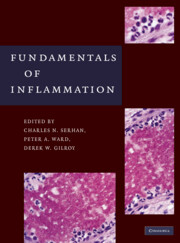Book contents
- Frontmatter
- Contents
- Contributors
- Preface
- PART I THE INFLAMMATORY RESPONSE – AN OVERVIEW
- 1 Acute and Chronic Inflammation
- 2 Resolution of Acute Inflammation and Wound Healing
- 3 Links between Innate and Adaptive Immunity
- PART II INDIVIDUAL CELL TYPES
- PART III CHEMICAL MEDIATORS
- PART IV IMMUNOPHARMACOLOGY
- PART V INFLAMMATORY DISEASES/HISTOLOGY
- PART VI ANIMAL MODELS OF INFLAMMATION
- Index
- References
3 - Links between Innate and Adaptive Immunity
from PART I - THE INFLAMMATORY RESPONSE – AN OVERVIEW
Published online by Cambridge University Press: 05 April 2014
- Frontmatter
- Contents
- Contributors
- Preface
- PART I THE INFLAMMATORY RESPONSE – AN OVERVIEW
- 1 Acute and Chronic Inflammation
- 2 Resolution of Acute Inflammation and Wound Healing
- 3 Links between Innate and Adaptive Immunity
- PART II INDIVIDUAL CELL TYPES
- PART III CHEMICAL MEDIATORS
- PART IV IMMUNOPHARMACOLOGY
- PART V INFLAMMATORY DISEASES/HISTOLOGY
- PART VI ANIMAL MODELS OF INFLAMMATION
- Index
- References
Summary
THE INNATE AND ADAPTIVE IMMUNE SYSTEMS: DEFINITIONS, CONTEXT, AND CONTRASTS
Standard accounts of the immune system emphasize the antigen-specific immunity and memory afforded by the adaptive immune system, contrasting it with the “nonspecific” defenses provided by the phylogenetically more ancient innate immune system. While study of the innate immune system has undergone a recent renaissance, most immunology textbooks still present innate immunity as an initial stopgap defense that holds the line until the “real” (efficient, effective, sophisticated) adaptive immune system can take over. There are obvious flaws in such formulations. First, while adaptive immunity may usefully be seen as a single system – with its cells (B and T lymphocytes) and antigen receptors (immunoglobulins [Ig], T-cell receptors) depending directly on the evolution of the recombination-activating gene (RAG) in jawed vertebrates – innate immunity, present in all metazoans, is a congeries of pathways. “Innate immune systems” is a much better term. Second, the innate immune systems are in no way less sophisticated than the adaptive immune system, having been under evolutionary pressure for far longer. Third, the innate immune systems are not of secondary importance; the adaptive immune system is directly dependent on the former for efficient and appropriate activation. Fourth, innate immune effector mechanisms are not less effective than adaptive immune effector mechanisms.
Information
- Type
- Chapter
- Information
- Fundamentals of Inflammation , pp. 28 - 38Publisher: Cambridge University PressPrint publication year: 2010
References
Accessibility standard: Unknown
Why this information is here
This section outlines the accessibility features of this content - including support for screen readers, full keyboard navigation and high-contrast display options. This may not be relevant for you.Accessibility Information
- 4
- Cited by
